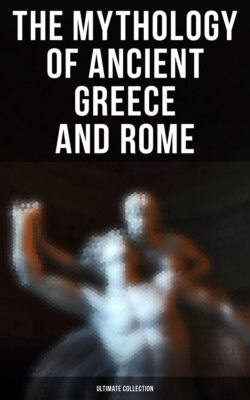Читать книгу The Mythology of Ancient Greece and Rome - Ultimate Collection - Homer - Страница 17
На сайте Литреса книга снята с продажи.
I. HERA (JUNO)
ОглавлениеI sing of golden-throned Hera, whom Rhea bore, an immortal queen, in beauty preeminent, the sister and the bride of loud-thundering Zeus, the lady renowned, whom all the Blessed throughout high Olympus honor and revere no less than Zeus whose delight is in the thunder. (Homeric Hymn to Hera. Translation by Andrew Lang.)
As wife of the Supreme god, Hera was naturally the guardian of the marriage state. The bride sacrificed to her, and matrons of the city were the priestesses of her temple. At Samos the annual celebration of her marriage with Zeus was the greatest of festivals. By Zeus she had three children, Ares (Mars), god of war, Hephæstus (Vulcan), god of the forge, and Hebe, goddess of youth. Though Hebe was originally also cup-bearer to the gods, for some reason, perhaps because she slipped one day when pouring the nectar, she was displaced by Gan’y mede, a Trojan prince. Zeus saw the boy on earth and loved him for his boyish charm and beauty. Assuming the form of his royal eagle, the god came upon Ganymede When he was watching his flocks on Mt. Ida, and carried him off to Olympus to be his cup-bearer. This aroused Hera's anger, not only against her husband but against the whole race of Trojans, whom ever after she pursued with relentless hatred. Indeed all Zeus's favorites among mortals and his children by mortal wives were objects of jealous hate to Hera.
Fig. 7. Hera.
Fig. 8. Ganymede and the Eagle.
Iris was the wind-footed, fleet messenger of Hera, who bore her commands to other gods and to mortals. As she flew down from Olympus men knew of her coming by the many-colored trail she left behind her; for Iris was the rainbow, the symbol of connection between earth and heaven.
Greek artists conceived of Hera as a woman in the full bloom of her age, of majestic form and carriage, with a serene and beautiful face, a conception inspired by the ideal for which she stood, the queenly protector of wifehood and motherhood. As a matron she was portrayed clad in a long full garment, and on her head a crown. Often she held a scepter, sometimes a pomegranate, the symbol of fertility for women and plants. Beside her often appears the peacock, his tail adorned by the hundred Argus eyes. (See p. 26.)
Fig. 9. Head of Hera.
Corresponding to Hera as wife of Zeus, in Roman worship stood Juno, the wife of Jupiter. She too in old times had been the special guardian of women and the marriage-tie.
